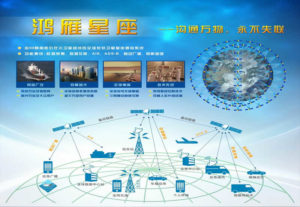
One of China’s largest space and satellite companies, the China Aerospace Science and Technology Corporation (CASC), has announced plans to build a 300-satellite mobile telephone communications network providing coverage for Chinese mobile telephone users, according to Chinese press reports.
The satellite communications mega-constellation, called Project Hongyan, will be built with the help of a recently established small satellite manufacturing facility at the Kasetsart University in Thailand, a country that is rapidly becoming a space and satellite powerhouse in Southeast Asia.
Project Hongyan will consist of more than 300 satellites in low-Earth orbit (LEO), terrestrial data processing centres, and various other supporting ground infrastructure located around the globe.
The mega-constellation is intended to provide mobile telephone coverage around the world for Chinese mobile users. Foreign mobile telephone and telecommunications companies are not permitted to operate in China, and with more and more Chinese nationals regularly traveling abroad for business and leisure, and China’s rapidly expanding geoeconomic presence globally, providing global coverage for these users has become a commercial and strategic imperative.
At the time of reporting no details about the size and capabilities of the Project Hongyan satellites is not known, but CASC has announced that it intends to have 60 of the 300 satellites in orbit by 2020.
Originally announced in 2016, Project Hongyan was initially supposed to consist of 60 satellites and 20 ground stations located around the world, but that number has since increased to 300.
“Project Hongyan will be done in three phases, and form a global low-orbit mobile internet,” said Yin Liming, Chief Executive Officer of China Great Wall Industry Corporation, a subsidiary of CASC.
Apart from providing global mobile telephone coverage for Chinese users, Project Hongyan will also provide broadband internet services, integrated data monitoring and communications for Internet of Things (IoT) sensors and devices, automatic ship identification (AIS) services for maritime domain awareness, and will improve the accuracy of Beidou, China’s satellite navigation system.
Thailand’s Kasetsart University will jointly develop Project Hongyan with the Beijing Tengyuxinwei Technology Co. Ltd. (BTTCL), an affiliate of the China Great Wall Industry Corporation.
According to a Memorandum of Understanding signed in November 2017 between BTTCL and Kasetsart University, the Chinese will build for the Thai institution a small satellite construction facility, capacity building of the satellite engineering required, and develop space technology and industrial capacity through Project Hongyan.
The cooperative venture began at the start of 2018, with the first Hongyan satellite from the Kasetsart University facility expected to be launched sometime in 2019.
Project Hongyan is one of two mega-constellation satellite communication ventures being pursued by Chinese entities.
Xingyun, a narrow-band constellation of 156 LEO mini-satellites will provide communications and data services for the Internet of Things. IoT will be a prominent feature of the infrastructure of the Chinese-led Belt and Road Initiative (BRI), and will require a global satellite network to ensure its functioning on land, at sea, and in the air.
Xingyun is being developed by China Aerospace Science and Industry Corporation (CASIC), a “sister” company of CASC.
While both Hongyan and Xingyun are mega-constellations similar to those being developed by Western companies such as OneWeb, SpaceX, LeoSat, and Iridium – among others – they are not necessarily in direct competition with these companies and their proposed services because of China’s protectionist and strict telecommunications laws and regulations that prevents non-Chinese companies from providing services and products in China.
Significantly, however, Hongyan and Xingyun are symbols of the political and economic model espoused by China versus the more laissez faire model (relatively speaking, at least) preferred among most Western countries. In that sense, the Chinese mega-constellations are part of a wider geoeconomic competition between China and Western countries led by the United States.


